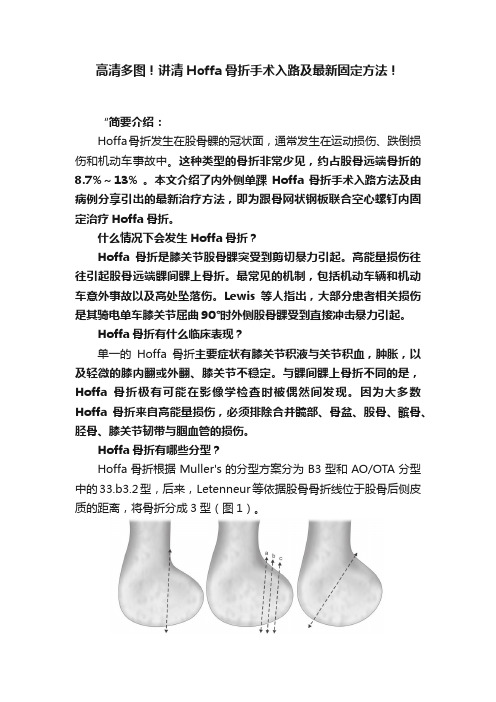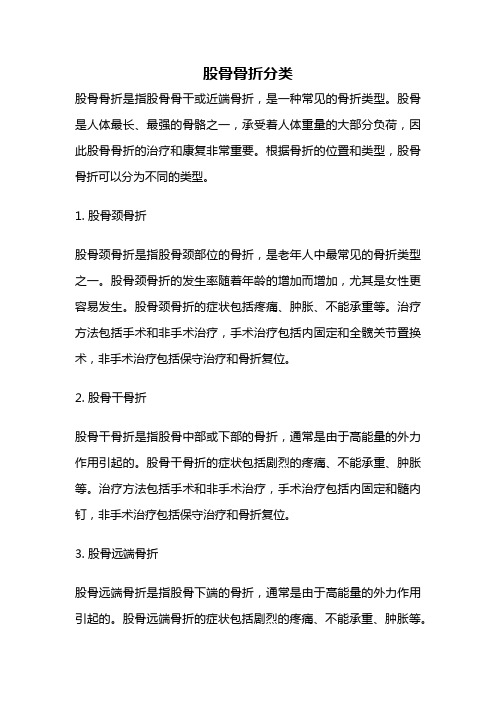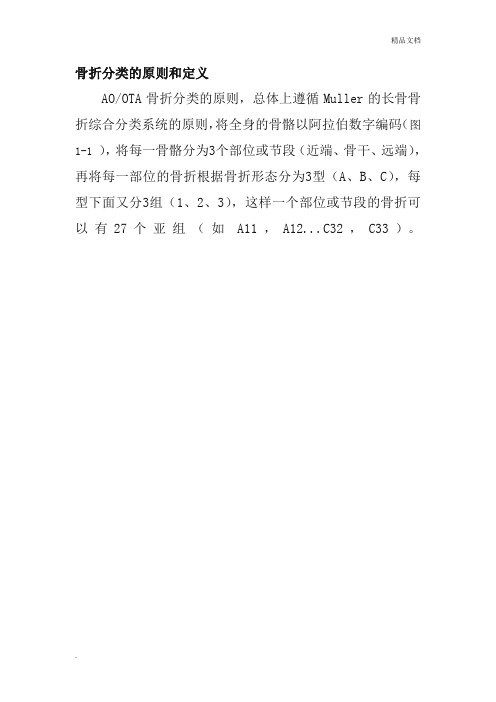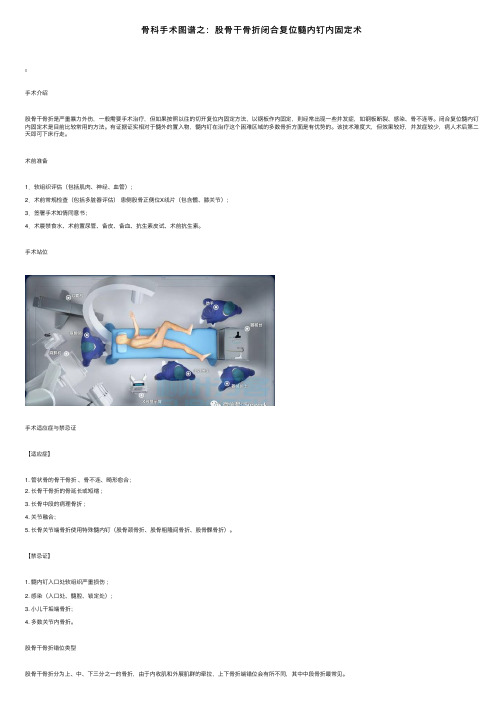股骨远端骨折手术图解
手术讲解模板:股骨骨骺分离闭合复位术

手术资料:股骨骨骺分离闭合复位术
概述:
4.目前常用的肢体延长方法 根据延长速度,可分为股骨一次延长和逐 日延长。前者因所延长的长度有限,并发 症较多,如血管神经损伤、骨愈合时间长, 甚至不愈合等,已较少采用。目前多采 用逐日延长,逐日延长的方法较多,主要 区别在于截骨部位和使用的外固定器械 (延长器)不同。例如Wagner采
手术资料:股骨骨骺分离闭合复位术
手术步骤:
如果系单纯股骨内髁或外髁骨折,即Salter-HarrisⅢ型和Ⅳ型骨骺损伤, 可直接用1~2枚螺丝钉经骨折线,横行或斜行固定,但要避免螺丝钉进入 骺板(图12.42.3-5A、B)。
手术资料:股骨骨骺分离闭合复位术
手术步骤:
手术资料:股骨骨骺分离闭合复位术
手术资料:股骨骨骺分离闭合复位术
概述:
取骨干截骨延长和悬臂式延长器,当达到 所需 长度后,需要自体骨植入和内固定; DeBastiani选择干骺端截骨,使用单臂外 固定器固定,骨痂形成后,再逐日延长; Ilizarov则采用环形延长-加压系统,进 行骺板延长和干骺端截骨延长,同样不需 要植骨和内固定。
手术资料:股骨骨骺分离闭合复位术
概述:
提出胫骨 延长术基础上发展了许多改进方法,如经 皮横穿胫骨上下端进针法,经皮骨钻孔、 闭合折断胫骨,腓骨截骨和胫腓下关节融 合术,防止踝关节外翻畸形等。 Anderson(1952)认为这种方法具有软组 织损伤轻、保留骨膜、促进局部骨组织生 长的优点。肢体延长术包括骨骼、肌肉、 神经及血管等
手术资料:股骨骨骺分离闭合复位术
概述:
骨折上下两端各 穿入两根克氏针进行固定牵引,从而增强 了牵引的拉力,防止了钢针滑脱,并提高 了骨延长的效果,该作者又在1927年提出 了胫骨延长术。 Bost(1956)采用斜形截骨和髓内针固定。 Westin(1967)在截骨缺损区,采用骨膜 包裹覆盖法达到延长的目的。目前在 Abbott
高清多图!讲清Hoffa骨折手术入路及最新固定方法!

高清多图!讲清Hoffa骨折手术入路及最新固定方法!“简要介绍:Hoffa骨折发生在股骨髁的冠状面,通常发生在运动损伤、跌倒损伤和机动车事故中。
这种类型的骨折非常少见,约占股骨远端骨折的8.7%~13% 。
本文介绍了内外侧单踝Hoffa骨折手术入路方法及由病例分享引出的最新治疗方法,即为跟骨网状钢板联合空心螺钉内固定治疗Hoffa骨折。
什么情况下会发生Hoffa骨折?Hoffa骨折是膝关节股骨髁突受到剪切暴力引起。
高能量损伤往往引起股骨远端髁间髁上骨折。
最常见的机制,包括机动车辆和机动车意外事故以及高处坠落伤。
Lewis等人指出,大部分患者相关损伤是其骑电单车膝关节屈曲90°时外侧股骨髁受到直接冲击暴力引起。
Hoffa骨折有什么临床表现?单一的Hoffa骨折主要症状有膝关节积液与关节积血,肿胀,以及轻微的膝内翻或外翻、膝关节不稳定。
与髁间髁上骨折不同的是,Hoffa骨折极有可能在影像学检查时被偶然间发现。
因为大多数Hoffa骨折来自高能量损伤,必须排除合并髋部、骨盆、股骨、髌骨、胫骨、膝关节韧带与腘血管的损伤。
Hoffa骨折有哪些分型?Hoffa骨折根据Muller's的分型方案分为B3型和AO/OTA分型中的33.b3.2型,后来,Letenneur等依据股骨骨折线位于股骨后侧皮质的距离,将骨折分成3型(图1)。
图1 Hoffa骨折Letenneur分型Ⅰ型:骨折线位于且平行于股骨干后侧皮质。
Ⅱ型:骨折线到股骨后侧皮质线的距离,又根据折线到后侧皮质骨的距离多少,分成Ⅱa, Ⅱb和Ⅱc亚型,Ⅱa型离股骨干后侧皮质最近,而Ⅱc离股骨干后侧皮质最远。
Ⅲ型:斜行骨折。
有哪些手术入路?Hoffa骨折在肢体骨折中的发生率较低,多见于单纯股骨外侧髁或内侧髁,双髁骨折少见。
据报道,股骨外侧髁比内侧髁更常见,文中只举例内、外侧单踝Hoff骨折手术入路:外髁Hoffa骨折的手术入路:1、直接外侧入路:•沿股骨外髁与Gerdy结节后缘连线作5cm左右纵行切口,可根据情况向上下延伸(如下图)。
股骨骨折分类

股骨骨折分类股骨骨折是指股骨骨干或近端骨折,是一种常见的骨折类型。
股骨是人体最长、最强的骨骼之一,承受着人体重量的大部分负荷,因此股骨骨折的治疗和康复非常重要。
根据骨折的位置和类型,股骨骨折可以分为不同的类型。
1. 股骨颈骨折股骨颈骨折是指股骨颈部位的骨折,是老年人中最常见的骨折类型之一。
股骨颈骨折的发生率随着年龄的增加而增加,尤其是女性更容易发生。
股骨颈骨折的症状包括疼痛、肿胀、不能承重等。
治疗方法包括手术和非手术治疗,手术治疗包括内固定和全髋关节置换术,非手术治疗包括保守治疗和骨折复位。
2. 股骨干骨折股骨干骨折是指股骨中部或下部的骨折,通常是由于高能量的外力作用引起的。
股骨干骨折的症状包括剧烈的疼痛、不能承重、肿胀等。
治疗方法包括手术和非手术治疗,手术治疗包括内固定和髓内钉,非手术治疗包括保守治疗和骨折复位。
3. 股骨远端骨折股骨远端骨折是指股骨下端的骨折,通常是由于高能量的外力作用引起的。
股骨远端骨折的症状包括剧烈的疼痛、不能承重、肿胀等。
治疗方法包括手术和非手术治疗,手术治疗包括内固定和全髋关节置换术,非手术治疗包括保守治疗和骨折复位。
4. 股骨转子间骨折股骨转子间骨折是指股骨转子间的骨折,通常是由于高能量的外力作用引起的。
股骨转子间骨折的症状包括剧烈的疼痛、不能承重、肿胀等。
治疗方法包括手术和非手术治疗,手术治疗包括内固定和髓内钉,非手术治疗包括保守治疗和骨折复位。
5. 股骨髁间骨折股骨髁间骨折是指股骨髁间的骨折,通常是由于高能量的外力作用引起的。
股骨髁间骨折的症状包括剧烈的疼痛、不能承重、肿胀等。
治疗方法包括手术和非手术治疗,手术治疗包括内固定和髓内钉,非手术治疗包括保守治疗和骨折复位。
6. 股骨骨盆联合骨折股骨骨盆联合骨折是指股骨和骨盆的联合骨折,通常是由于高能量的外力作用引起的。
股骨骨盆联合骨折的症状包括剧烈的疼痛、不能承重、肿胀等。
治疗方法包括手术和非手术治疗,手术治疗包括内固定和全髋关节置换术,非手术治疗包括保守治疗和骨折复位。
股骨远端骨折的手术治疗

股骨远端骨折的手术治疗1. 引言1.1 疾病概述股骨远端骨折是一种常见的骨折类型,通常指的是股骨近端(髋关节处)或股骨干骨折。
这类骨折往往是由于高能量外伤(如车祸、摔倒)或骨质疏松等原因引起的。
股骨远端骨折不仅会导致严重的疼痛和功能障碍,还可能对患者的生活质量造成严重影响。
股骨远端骨折的治疗通常需要及时采取手术干预,以恢复骨折部位的正常结构和功能。
手术治疗能够有效稳定骨折部位,促进骨折的愈合,减少并发症的发生,尽快恢复患者的关节功能和活动能力。
对于股骨远端骨折患者来说,手术治疗具有重要的意义,可以帮助他们尽快康复,减轻疼痛,恢复正常生活。
在接受手术治疗之前,患者需要充分了解病情及手术相关信息,与医生密切沟通,做好充分的心理准备。
通过手术治疗,股骨远端骨折患者有望重获健康和活力。
1.2 手术治疗的重要性股骨远端骨折是一种常见的骨折类型,尤其在老年人和骨质疏松的患者中更为常见。
在面对股骨远端骨折的治疗选择时,手术治疗的重要性不容忽视。
手术治疗可以帮助恢复患者的髋关节功能,减少疼痛,提高生活质量。
手术治疗可以有效复位和固定骨折端,避免不良愈合和畸形愈合的发生。
通过外科手术的方式,医生可以精确地重新定位骨折部位,确保骨折端的正确对齐,从而有利于骨折愈合的过程。
这对于恢复髋关节的功能至关重要,避免出现步态异常、疼痛和功能受限等问题。
手术治疗还可以减少并发症的发生率。
相比于保守治疗,手术治疗可以更好地控制骨折部位的稳定性,减少术后感染、血栓形成等并发症的风险。
通过及时有效的手术干预,可以更好地保障患者的康复过程,降低治疗的风险。
2. 正文2.1 手术前的准备工作股骨远端骨折是一种严重的骨折类型,需要通过手术治疗来恢复骨折部位的功能和稳定性。
在进行手术治疗之前,患者需要进行一系列的准备工作,以确保手术顺利进行并降低手术风险。
患者需要进行全面的身体检查,包括血液检查、心电图、X光片等,以评估患者的身体状况和骨折的具体情况。
骨折分型图示

骨折分类的原则和定义AO/OTA骨折分类的原则,总体上遵循Muller的长骨骨折综合分类系统的原则,将全身的骨骼以阿拉伯数字编码(图1-1 ),将每一骨骼分为3个部位或节段(近端、骨干、远端),再将每一部位的骨折根据骨折形态分为3型(A、B、C),每型下面又分3组(1、2、3),这样一个部位或节段的骨折可以有27个亚组(如A11,A12...C32,C33)。
图1-1 骨骼定位编码1.骨骼编码骨折该系统将全身的骨骼以阿拉伯数字编码(颅面骨和胸骨不在本范围描述),包括有肱骨(1)、尺桡骨(2)、腕骨(24)、掌骨(25)、指骨(26)、股骨(3)、胫腓骨(4)、髌骨(45)、距骨(72)、跟骨(73)、足舟骨(74)、楔骨(75)、骰骨(76)、跖骨(81)、趾骨(82)、脊柱(5)、骨盆(6)、锁骨(06)、肩胛骨(09)。
2.骨骼节段长骨分为不同的节段,包括近端(1)、骨干(2)、远端(3);胫腓骨增加了踝部(4);骨盆分为骨盆环(1)、髋臼(2)。
骨干(2)是指在骨的近端和远端之间的节段。
近端(1)和远端(3)定义为骨骺和干骺端部位,Heim用平方法划分长骨的近端和远端为长骨两端的正方形区域,其边长为骨骺最宽处。
股骨近端是例外,股骨近端指股骨近侧经小转子下缘横线以近的部分(表1-1)。
表1-1 长骨的近端和远端二、长骨骨干骨折分类长骨骨干骨折根据骨折复杂程度分为A、B、C三型,每一型可再分为3组(表1-2)。
A型——简单骨折(simple fractures)一处单独的环绕骨干的破裂,只有2个骨折块。
可分为3组:A1—简单螺旋骨折;A2—简单斜行骨折,即骨折面与长骨垂线的交角大于30°;A3—简单横行骨折,即骨折面与长骨垂线的交角小于30°。
若骨皮质碎片小于10%则忽略不计。
B型——楔形骨折(wedge fractures)有一块以上的中间骨片,复位后主要骨折块之间有骨皮质接触,基本恢复了长度和力线。
《股骨远端骨折》ppt课件

1髁上骨折( AO之A型)
骨折类型 AO分型 受伤机制分型
1髁上骨折( AO之A型)
症状与体征 肿胀、疼痛与於斑 异常活动、骨擦音及畸形 注意远侧血循感觉和运动 隐形的或潜在的开放型骨折
1髁上骨折( AO之A型)
治疗 无移位 外固定
1髁上骨折( AO之A型)
治疗 有移位 牵引小夹板固定 手术治疗
容易发生骨折延迟愈合、不愈合、膝关节 内翻、膝关节的僵硬,长期卧床的并发症, 并大大降低了患者的生活质量。
2 髁间骨折( AO之c型)
手术治疗--- 关节面复位更好,利于早期活动,减 少了膝关节僵硬及创伤性关节炎的机会。选用可靠 的固定方式,减少了骨折不愈合的机会 手术要点: 良好的下肢力线 平整的关节面 尽可能选用具有角度稳定性的内固定器材 保持内侧壁的连续性
受伤机制 高处坠落,膝关节伸直位,导致的单髁或双 髁劈裂骨折 高处坠落,膝关节屈曲位,导致的后髁骨折 来自前方的暴力,通过髌骨传导至股骨外髁
3单髁骨折( AO之B型)
临床诊断 一般症状与体征 内外翻试验假阳性,不要误诊为侧副韧带损 伤
3单髁骨折( AO之B型)
治疗
有明显移位的一般均需要手术切开复位 内固定
股骨远端骨折并发症
3 膝关节内外翻,大部分是内翻畸形 预防措施 尽可能选用具有角度稳定性的内固定器械 对于非角度稳定性的器械,一定要保证内 侧皮质的连续性。 注意膝关节是存在着生理性外翻的
股骨远端骨折并发症
4 骨折的延迟愈合与不愈合 预防措施 可靠的固定方式 充分的植骨,尤其是对于内侧骨皮 质的缺损,更是要充分植骨
股骨远端骨折并发症
5
肌肉的萎缩 预防措施 终末伸膝锻炼 股四头肌等长收缩 渐进性肌肉耐力的锻炼
手术讲解模板:股骨大粗隆远端移位术

手术资料:股骨大粗隆远端移位术
概述:
定的指导意义。因此,他根据X线片股骨 头骨骺坏死范围,将股骨头骨骺坏死分为 4型或4级。Ⅰ型:正位片显示骨骺呈轻度 囊性变,或软骨下骨折。但无塌陷、死骨 形成,亦无干骺端变化。侧位X线片仅见 骨骺前部分受累。Ⅱ型:正位X线片显示 有中央致密的椭圆形团块,其内外侧均有 存活的柱状骨皮质,可保持愈
手术资料:股骨大粗隆远端移位术
术后护理:
正确舒适的体位,能维持有效的牵引力, 除头低足高位外,患肢保持外展30°稍内 旋位,在不影响牵引效果的前提下,给予 舒适的体位,指导患者做引体向上运动, 利用床上牵引架拉手及健侧腿蹬在床面上, 将整个上身和臀部抬起来,每隔2 h做一 次,夜间睡眠时每间隔4 h做一次,每次 抬起至少15 s,此锻炼也是预防褥疮的有 效措施。
股骨大粗隆远 端移位术
手术资料:股骨大粗隆远端移位术
股骨大粗隆远端移位 术
科室:骨科、小儿外科 部位:腿
手术资料:股骨大粗隆远端移位术
麻醉: 全身麻醉或硬脊膜外腔阻滞麻醉。
手术资料:股骨大粗隆远端移位术
概述:
股骨大粗隆远端移位术用于股骨头缺血性 坏死的手术治疗。儿童股骨头骨骺缺血性 坏死又称为Legg-Calve-Perthes病。虽然 该病具有自限性,即骨骺出现缺血性坏死 后,经过碎裂、吸收、再血管化和骨化等 病理过程,最后股骨头骨骺修复而静止。 其自然病程约需18~36个月。早期发现早 期治疗
手术资料:股骨大粗隆远端移位术
概述: 之,外侧柱受累程度越重,预后越差。
手术资料:股骨大粗隆远端移位术
概述:
许多研究结果表明,发病年龄在6岁以下 者,无论采取哪种治疗方法,其最终结果 是比较好的。而病儿在7岁以上者,则预 后常常较差。因此,在选择治疗方法时, 应该考虑发病年龄这一重要因素。
股骨远端骨折 (2)PPT讲稿

Muller分型
Muller依据骨折部位及程度将股骨远端分为
三
类
九
型
A型骨折:仅累及远端股骨干伴有不同程
度
粉
碎
骨
折
B型骨折:为髁部骨折。B1型:外髁矢
状
劈
裂
骨
折
பைடு நூலகம்
;
B2 型 : 内 髁 矢 状 劈 裂 骨 折 ;
B3 型 : 冠 状 面 骨 折
C型骨折:为髁间T形及Y形骨折。
C1 型 : 为 非 粉 碎 性 骨 折 ;
股骨髁周围有关节囊、韧带、肌肉及肌
诊断
•
股骨远端骨折膝上出现明显肿胀,股
骨髁增宽,可见畸形,做膝关节主动及被动
活动时,可听到骨擦音。偶可出现肢体远端
血管和神经损伤体征,X线片一般满足骨折
范围及移位,必要时拍斜位X线片,来明确
髌股关节构形和胫股关节面关系。应重视合
并损伤,当髁部骨折合并股骨和胫骨近端骨
股骨远端骨折 (2)课件
概述
股骨远端骨折是指股骨下
端9cm内的骨折,包括髁上 和髁间骨折。 其发生率占 所有股骨骨折的4%,由于 骨折部位骨结构的特点, 骨折后多为粉碎性,不稳 定骨折,难以牢固固定, 骨折接近膝关节,波及到 关节面,易影响膝关节活 动,是最难治的骨折之一。
解剖与解剖生理
股骨远端粗大呈“喇叭”状,主要由松质
手术技术——术中体位
手术技术——切口显露
手术技术——切口显露
手术技术——拉力螺钉固定
手术技术——动力髁内固定DCS
手术技术——髁接骨板固定
手术技术——粉碎性骨折的固定
手术技术——逆行髓内钉固定DFN
手术技术——外固定支架固定
股骨骨折

临床操作
骨牵引时的注意事项
随时注意调整牵引针方向、重量及肢体位置, 以防成角 畸形。
注意患肢远端的血液循环, 密切观察皮肤的颜色、温度, 足背动脉的搏动及足趾活动情况等; 预防腓总神经受压;
加强功能锻炼鼓励并指导患者主动活动踝关节及足趾屈
伸, 以促进血液循环, 利于机体修复, 促进骨折愈合。
骨 折 移 位 机 理
上1/3骨折 近折段 远折段 中1/3骨折 远折段 下1/3骨折 远折段 向外成角、缩短畸形 髂腰肌、臀中 屈曲、外旋和外展肌、臀小肌和髋 关节外旋诸肌 内收肌群 向上、向后、向内 按暴力的撞击方向而成角 内收肌 向外成角 向后倾倒 腓肠肌 向后倾倒、可压迫或刺激腘动静脉和坐 骨神经
股 骨 干 骨 折
定义
股骨干骨折:股骨小转子下
4cm之间的骨折。 2~5 cm至股骨髁上2~
股骨:是体内最长、最大的骨骼, 而且是下肢主要负
重骨, 如果治疗不当, 将引起下肢畸形及功能障碍。
其髓腔呈圆形,上、中1/3的内径大体一致,下1/3的
内径较膨大。
解剖
重要血管及神经解剖图
致伤原因及病理
临床表现、体征及辅助检查
1. 2.
一般有明显的受伤史。 专科体征:伤肢的剧痛、活动障碍、局部肿胀及压痛, 有异常活动,骨擦感及骨擦音;畸形(如患肢短缩、 远端肢体外旋)。
3. 4.
有并发症者伴相应症状及体征。 X-ray:股骨正侧位片、同侧髋关节及膝关节正侧片,
定骨折类型和伴随损伤。
治疗原则
谢谢!!能给骨折部位提 供轴向压力, 可以缩小骨折间隙, 促进骨折愈合。
普通髓内针内固定
优点:依靠弹性相嵌原理固定骨折, 能促进骨痂大
股骨远端骨折

概述
• 股骨远端骨折是指股骨下端15cm内的骨折,包括髁上 和髁间骨折。 其发生率占所有股骨骨折的6%,由于骨 折部位骨结构的特点,骨折后多为粉碎性,不稳定骨折, 难以牢固固定,骨折接近膝关节,波及到关节面,易影 响膝关节活动,是最难治的骨折之一。
解剖与解剖生理
• 股骨远端粗大呈“喇叭”状,主要由松质骨组成,外侧髁比内侧 髁宽大,内侧髁较狭窄,其所属的位置较低。股骨两髁关节面于 前方联合,形成一矢状位线凹,即髌面,当膝伸直时,以容纳髌 骨。在股骨两髁间有一深凹,为髁间窝,膝交叉韧带经过其中间, 前交叉韧带附着于外髁内面后部,而后交叉韧带附着于股骨内髁 外面的前部。股骨髁解剖上的薄弱点在髁间窝。 股骨髁周围有关节囊、韧带、肌肉及肌腱附着,骨折块受这 些组织的牵拉不易复位,复位后难维持,股骨远端后方有动脉及 神经,严重骨折时,可造成其损伤。
髁间骨折( AO之c型)
•手术治疗--- 关节面复位更好,利于早期活动, 减少了膝关节僵硬及创伤性关节炎的机会。选 用可靠的固定方式,减少了骨折不愈合的机会
治疗-手术
髁上及髁间骨折--角钢板
治疗-手术
髁上及髁间骨折-动力髁螺钉
治疗-手术
• 髁上及髁间骨折-支持钢板
治疗-手术
• 髁上及髁间骨折-锁定钢板
治疗-手术
• 髁上及髁间骨折-逆行带锁髓内针固定
逆行带锁髓内针固定
• 通常情况下,顺行髓内钉治疗股骨近端 15 cm 以内的骨折效果不 理想,极易出现移位现象,且会因骨折端应力集中,引发锁钉断 裂。而相较于顺行髓内钉,逆行髓内钉的工作力臂明显较短,促 使固定的力学稳定性得到提升。逆行髓内钉能对手术时间进行控 制,有效减少出血量,不会给患者髋外展肌功能造成不利影响。 逆行髓内钉在伴有颅脑损伤患者中的应用,对其术后髋周围异位 骨化现象进行消除。同时相较于顺行髓内钉,逆行髓内钉不会导 致患者出现会阴部神经损伤,可经由一个切口处理伴有膝关节开 放性外伤的患者,能适用于孕妇、髋周皮肤条件差、股骨近端解 剖异常、肥胖等患者。
手术讲解模板:股骨远端骨肿瘤切除同种骨段移植重建术

手术资料:股骨远端骨肿瘤切除同种骨段移植重建术
注意事项: 2.显露肿瘤时注意结扎股动、静脉和腘动、 静脉的分支。
手术资料:股骨远端骨肿瘤切除同种骨段移植重建术
注意事项: 3.髓内固定不可过松,应选择内锁髓内钉 固定。骨断端对合必须紧密。
手术资料:股骨远端骨肿瘤切除同种骨段移植重建术
注意事项: 4.必须妥善修复膝关节内外侧副韧带、交 叉韧带和关节囊,否则术后膝关节将不稳 定。
手术资料:股骨远端骨肿感染 多发生于手术后1~2个月。有时 先有稀薄液体渗出,说明植骨吸收液化, 有时可在渗出液中培养出细菌。一旦发生 感染,骨段移植术即告失败。
手术资料:股骨远端骨肿瘤切除同种骨段移植重建术
并发症:
2.关节不稳,关节软骨退变,关节面塌陷。 此类并发症一般发生于术后2~3年。术后 1年时,关节软骨已完全退变、剥脱或纤 维化。
手术资料:股骨远端骨肿瘤切除同种骨段移植重建术
概述:
手术资料:股骨远端骨肿瘤切除同种骨段移植重建术
概述:
手术资料:股骨远端骨肿瘤切除同种骨段移植重建术
适应证: 股骨远端骨肿瘤切除同种骨段移植重建术 适用于:
手术资料:股骨远端骨肿瘤切除同种骨段移植重建术
适应证: 1.股骨远端具有侵袭性的良性骨肿瘤。
股骨远端骨肿瘤切除 同种骨段移植重建术
手术资料:股骨远端骨肿瘤切除同种骨段移植重建术
股骨远端骨肿瘤切除同种骨段移 植重建术
科室:骨科 部位:股骨
手术资料:股骨远端骨肿瘤切除同种骨段移植重建术
麻醉: 硬膜外麻醉、长效腰麻或全麻。
手术资料:股骨远端骨肿瘤切除同种骨段移植重建术
概述:
股骨远端是骨肿瘤好发部位之一,肿瘤常 破坏股骨远端大部。借助骨段切除术治疗 股骨下端骨肿瘤,利用带关节软骨的同种 骨进行关节成形术,可达到切除肿瘤、保 全肢体的目的。股骨局部解剖见下图(图 3.1.3.3-1,3.1.3.3-2)。
下肢骨折牵引图片2

1、悬吊牵引法
图3-58 Bryant氏皮 牵引
在牵引时,除保持 臀部离开床面外, 并应注意观察足部 的血液循环及包扎 的松紧程度,及时 调整,以防足趾缺 血坏死。
2.动滑车皮肤牵引法
适用于5岁至12岁儿童(图3-59)。 在膝下放软枕使膝部屈曲,用宽布带 在腘部向上牵引,同时小腿行皮肤牵 引,使两个方向的合力与股骨干纵轴 成一直线,合力的牵引力为牵引重力 的二倍。有时亦可将患肢放在托马氏 夹板及Pearson氏连接架上,进行滑动 牵引。牵引前可行手法复位,或利用 牵引复位。
病因与分类
一、病因: 中、老年人的骨质疏松 轻微扭转暴力 青少年则需较大暴力
二、分类
:1.按骨折线分类 ⑴股骨头下型骨折:骨折线位于股骨头下。 ⑵ 经股骨颈骨折:骨折线位于股骨颈中部 ⑶股骨颈基底骨折:骨折线位于股骨颈 与大小转子间连线 处 头下型骨折对股骨头血供的影响最大,基底型 骨折对股骨头血供的影响最小
第三节 股 骨 干 骨 折
fracture of the shaf of the femur
股骨干骨折是指粗隆下、股 骨髁上这一段骨干的骨折,占全 身骨折的4~6%,男性多于女性, 约2.8∶1。10岁以下儿童占多数, 约为总数的1/2。
第三节 股骨干骨折
一、解剖概要 二、病因、类型及骨折移位机理 三、临床表现与诊断 四、治疗 五、护理要点
第二节 股骨转子间骨折
解剖: 1.部位:大、小转子之间,其内为松质 骨是股骨干与股骨颈的交界处,承受的 剪式应力最大。 2.股骨矩:决定了转子间骨折的稳定 性 , 位于股骨颈、干连接处内后方的 致密纵形骨板
骨科手术图谱之:股骨干骨折闭合复位髓内钉内固定术

⼿术适应症与禁忌证【适应症】1. 管状⾻的⾻⼲⾻折、⾻不连、畸形愈合;本⼿术采⽤经阔筋膜张肌⼊路1. 在股⾻⼤转⼦顶端上⽅2厘⽶做2-3厘⽶的切⼝;2. 切开阔筋膜张肌,找到梨状窝。
术后康复⿎励进⾏髋、膝关节活动度练习,出院之前应⾏股四头肌训练和直腿抬⾼练习。
伤⼝愈合后⾏髋外翻训练。
前六周使⽤拐或步⾏器等助⾏器辅助⾏⾛,建议此时进⾏髋和膝关节活动度练习和肌⼒训练。
六周后如果X线⽚表现为进⾏性愈合,且⼒量获得恢复,即可完全独⽴⾏⾛。
⼿术步骤本病例为股⾻⼲中三分之⼀⾻折的A型⾻折。
【体位】1. 患者侧卧于⼿术床上,于⼤腿间及健肢⼩腿腓总神经区域垫软枕。
【消毒铺⼱】2. 患肢消毒铺⼱裹⾜,暴露出髋部、⼤腿以及膝关节部分。
【切开暴露】3. 在股⾻⼤转⼦顶端上⽅2cm做2-3cm的切⼝。
4. ⽌⾎钳钝性分离肌⾁直⾄股⾻⼤转⼦,切开⾻膜。
【复位、植⼊髓内钉】5. 通过切⼝将⼊路器顶到梨状窝上,C臂机透视确认⼊路器与股⾻⼲轴线平⾏。
7. 取下蜂窝导向器。
8. 将12.5mm开⼝软钻连接到动⼒⼯具,通过⼊路器在股⾻近端钻孔。
开⼝软钻组合可以将股⾻近端开⼝直径扩⼤⾄14mm。
9. 取下12.5mm开⼝软钻和导针。
10. 复位杆穿过⼊路器,于C臂透视下,对⾻折进⾏复位,助⼿“滑雪橇式”纵向牵引患肢,利于复位杆插⼊⾻折远端。
12. 取下复位杆。
13. 使⽤8mm空⼼软钻沿着圆头导针进⾏扩髓;依次加⼤软钻型号,直⾄扩髓时声⾳变为“嗒嗒”,扩髓完成后取下软钻;根据最终软钻的直径,选择髓内钉的直径(⽐软钻直径⼩0.5mm或1mm)。
15. 取下⼊路器和14mm软钻,沿着导针置⼊髓内钉,髓内钉到达位置后,取出导针,于C臂机透视下确认髓内钉与股⾻轴线对齐,近端2个螺钉都能放置于⼤粗隆上。
16. 使⽤⽪肤保护套筒穿过导引孔直⾄股⾻⽪质,将6.4mm钻头(带刻度)连接到⾻动⼒,进⾏钻孔,但不通过对侧⽪质,钻到⼩转⼦处,于套筒顶端读出钻上的刻度,作为打⼊螺钉的长度。
- 1、下载文档前请自行甄别文档内容的完整性,平台不提供额外的编辑、内容补充、找答案等附加服务。
- 2、"仅部分预览"的文档,不可在线预览部分如存在完整性等问题,可反馈申请退款(可完整预览的文档不适用该条件!)。
- 3、如文档侵犯您的权益,请联系客服反馈,我们会尽快为您处理(人工客服工作时间:9:00-18:30)。
These figures demonstrate the intracondylar extension of the fracture and a free intercondylar fragment (arrows).
FEMORAL AXIS
PLANNED SCREW POSITIONS When planning for the lag screw fixation, the surgeon must leave room for the lag screw of the fixed angle device or intramedullary nail.
As additional screws are placed, better fixation of the proximal fragment is obtained.
The final radiograph demonstrating the parapatellar incision for reduction of the joint and the percutaneous incisions utilized for the placement of the screws.
A percutaneous incision is used to allow for the placement of three screws through this incision. This image demonstrates the drill being introduced percutaneously into the hole and drilling through the plate into the femur.
A 7-10cm lateral parapatellar incision is made which can be extended proximally into a formal lateral approach to the femur if necessary. The intercondylar reduction is performed through this limited arthrotomy.
AP VIEW
LATERAL VIEW
AP and lateral radiographs demonstrating that the plate is against the femur and the metaphysis is generally reduced.
The lateral radiograph can be used in a similar fashion to a perfect circle technique used in nailing to place the proximal screws percutaneously.
LATERAL VIEW AP VIEW
LATERAL VIEW AP VIEW
AP and lateral radiograph demonstrating the position of the lag screw as templated. Note that with traction, both the AP and lateral radiographs are manipulated such that the metaphysis is reduced.
After the lag screw is placed, the appropriate sized fixed angle plate is slid subperiosteally up the femur. Notice the bolster, which is supporting the fracture in a reduced position.
After the plate is advanced subperiosteally up the femur, the distal fragment is manipulated such that the plating engages the lag screw.
After the plate is advanced subperiosteally up the femur, the distal fragment is manipulated such that the plating engages the lag screw.
LATERAL VIEW AP VIEW
AP and lateral radiographs demonstrating early callus formation at six weeks.
Periarticular or standard clamps are used to manipulate and reduce the fracture which is stabilized with the templated 6.5 mm lag screws with washers. The screws are placed anterior and posterior to the planned position of the fixed angle device.
Note the anatomic reduction of the articular surface. At this point, the articular surface is reconstructed and the metaphyseal component of the fracture is still unfixed.
AP view of a comminuted C3 intraarticular distal femur fracture.
Lateral view demonstrating the typical extension deformity caused by the pull of the origin of the gastrocnemius muscles from the posterior distal femur.
95° °
AP radiograph demonstrating the angle at which the guidewire for the fixed angle lag screw should be placed. It should be parallel with the distal femoral articular surface, which is at approximately 95o to 98o from the femoral shaft.
The size of the plate held up against the leg after fixation.
Immediate postoperative AP radiograph
Lateral radiograph immediately postoperative, demonstrating anatomic alignment of the metaphyseal region, as well as the joint.
LATERAL VIEW AP VIEW
This requires a bolster underneath the metaphyseal fracture and some flexion of the knee to correct the extension deformity of the quadriceps. The dotted line represents the axis of the femur where the plate will be placed.
The first screw is the most proximal to seat the plate.
As the most proximal screw is placed, it pulls the femoral shaft against the plate.
As the most proximal screw is placed, it pulls the femoral shaft against the plate.
